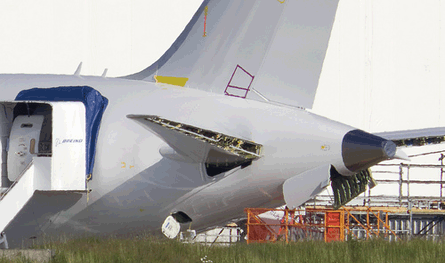As the supply chain came off a 24-manufacturing day hold in early June to allow supply partners to catch up on design changes and part shortages, workmanship issues on key structural areas of the aircraft again reared its head.
On 24 June Boeing had to disclose that it was forced to undertake inspections on the entire fleet of the horizontal stabilisers built by Alenia Aeronautica in Foggia, Italy, following the discovery of over-torqued fasteners and improperly installed shims in the rear spar.
Programme sources say the gaps, which the shims are intended to fill, range between 0.25cm and almost 0.5cm, and the ones used to fill gaps in the horizontal stabiliser became compressed after fasteners were over-torqued as a means of pulling the surfaces together, causing a "pre-load" condition that can undermine the fatigue life of the structure.
 |
|---|
© Liz Matzelle |
While Boeing maintains that the fleet had not been "grounded", the company decided not to fly each aircraft until it underwent two-day inspections before returning to flight-test operations.
The company insists that quality "escapes" such as the one found in the horizontal stabiliser is not uncommon during the early part of a programme, the episode was another in a series of workmanship issues that prompted an internal inquiry as to how 25 horizontal stabilisers could have been shipped to Everett over three years without notice.
Nearly a year ago, Boeing ordered a work stoppage at Alenia after wrinkles in the skin of the composite fuselage barrels exceeded tolerances.
"It turns out [the issue] is fairly deeply imbedded in the assembly," says Scott Fancher, vice-president and 787 programme general manager, referring to the issue with the horizontal stabiliser. "So we're in the process of auditing the records associated with that to understand whether or not there's a systemic issue with the escape or whether it's a one-off."
Source: Flight International























